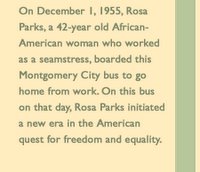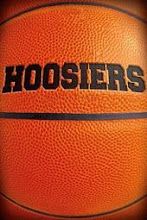Rosa Parks - 1913 - 2005


It was hot in the summer of 1963, particularly on Ringgold Street where the houses had no air conditioning and during summer, if you were a kid, you stayed outside until you parents made you come in for a bath. This particular day, the sun beat down and I remember going inside our house and the old Westinghouse fan which always sat between the kitchen and living room was running full blast, as it would until late in the evening when we might turn it down to medium so our house would be quieter for sleeping.
My mother was watching television which was unusual for her during the day. She told me to come in and watch "something that was very important". I noticed many black people (which many called negros or colored people in 1963) as far as you could see from Lincoln Memorial to the Capitol steps, as well as sitting and standing on both sides or the reflecting pool on the mall in Washington D.C.
This would become known as the "March on Washington" which signaled the true beginning of the Civil Rights Movement in America. I watched it live on black and white television. It was August, 28, 1963. An estimated 250,000 people gathered in front of the Lincoln Memorial in Washington D.C. to urge support for pending civil rights legislation. The event was highlighted by the Rev. Martin Luther King Jr's "I Have A Dream" speech delivered from the steps of the Lincoln Memorial.
I remember Martin Luther King giving this speech and I remember Charlton Heston being shown on televison with the leaders of the movement. I thought this was very cool as my reference to Charlton Heston was as Ben Hur in the movie by the same name. He was a democrat in those days and very active in issues viewed as liberal. My mother explained to me what was going on and I remember my parents talking about the Civil Rights Movement at the dinner table.
This year, in the fall of 2005 I am reminded of these significant events and how I processed them as a child and as an adult through the death of Rosa Parks, at 92. Ms. Parks died Monday, October 25, 2005 and many refer to her as the "Mother of the Modern-Day Civil Rights Movement" for not giving up her seat to a white passenger on a city bus in Montgomery, Alabama in 1955. The segregation laws in Montgomery at this time required her to give up her seat.
Sparking the modern civil rights movement in the United States by this event, Rosa Park's arrest for breaking Montgomery segregation laws started a boycott of the city bus line that lasted 381 days. This eventually lead to the 1956 US Supreme Court ruling declaring segregation illegal on public buses.
Mrs. Parks made history again after her death this fall as she became the first woman and only the second African-American to lie in honor in the Capitol Rotunda in Washington. She is entombed in a mausoleum at the prestigious Woodlawn Cemetary, where some of Detroit's leading citizens have been laid to rest.
I am fortunate to have experienced the tremendous progress we have made the last 50 years with civil rights in America. I am fortunate to have had parents who helped me understand the importance of this movement and I continue my commitment to develop my own children's view and contribution to our world through understanding the importance of acceptance, equality, tolerance.
It is important each day to remind ourselves of the words Thomas Jefferson wrote in our Declaration of Independence in 1776:
"We hold these truths to be self-evident, that all men are created equal, that they are endowed by their Creator with certain unalienable Rights, that among these are Life, Liberty and the Pursuit of Happiness."
We also must remind ourselves of Abraham Lincoln's Gettysburg Address where he began:
"Fourscore and seven years ago our fathers brought fourth on this continent a new nation, conceived in liberty and dedicated to the proposition that all men are created equal."
And lastly, we must remember Martin Luther King, Jr's famous "I Have a Dream" speech:
"I have a dream that one day this nation will rise up and live out the true meaning of its creed: "We hold these truths to be self-evident: that all mean are created equal."
"I have a dream that one day on the red hills of Georgia the sons of former slaves and the sons of former slave owners will be able to sit down together at the table of brotherhood."
"I have a dream that my four little children will one day live in a nation where they will not be judged by the color to their skin but by the content of their character."
"I have a dream that one day down in Alabama, with its vicious racists, with its governor having his lips dripping with the words of interposition and nullification; that one day right down in Alabama little black boys and black girls will be able to join hands with little black boys and white girls as sisters and brothers."
"I have a dream today."






